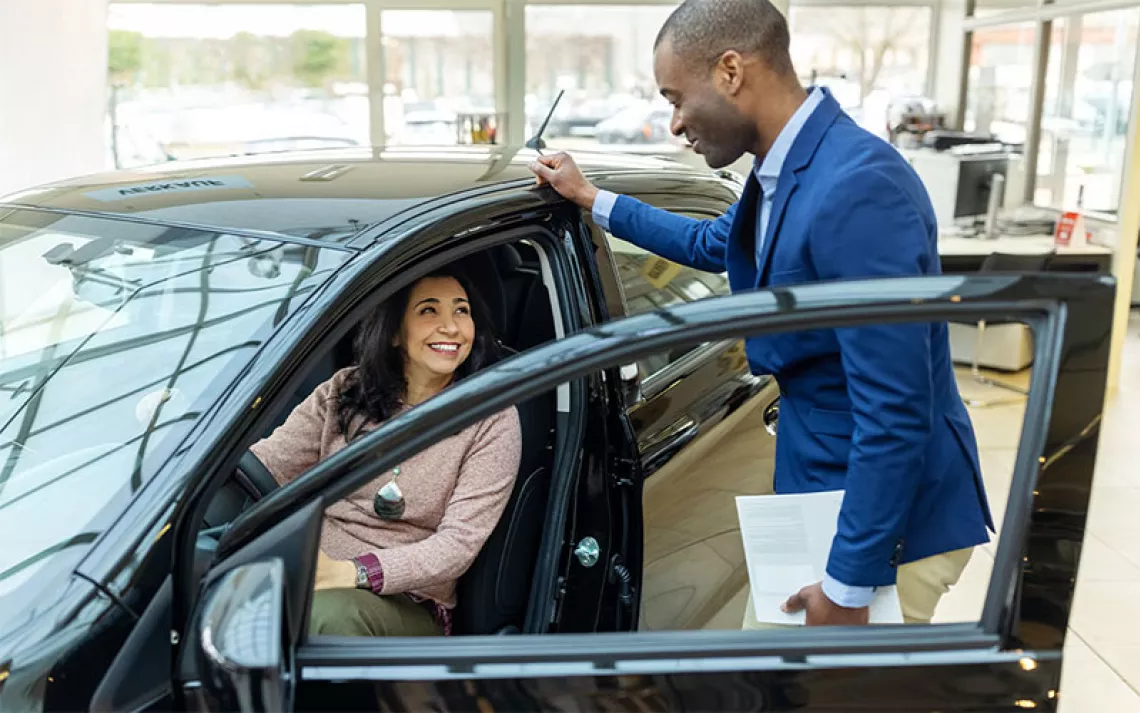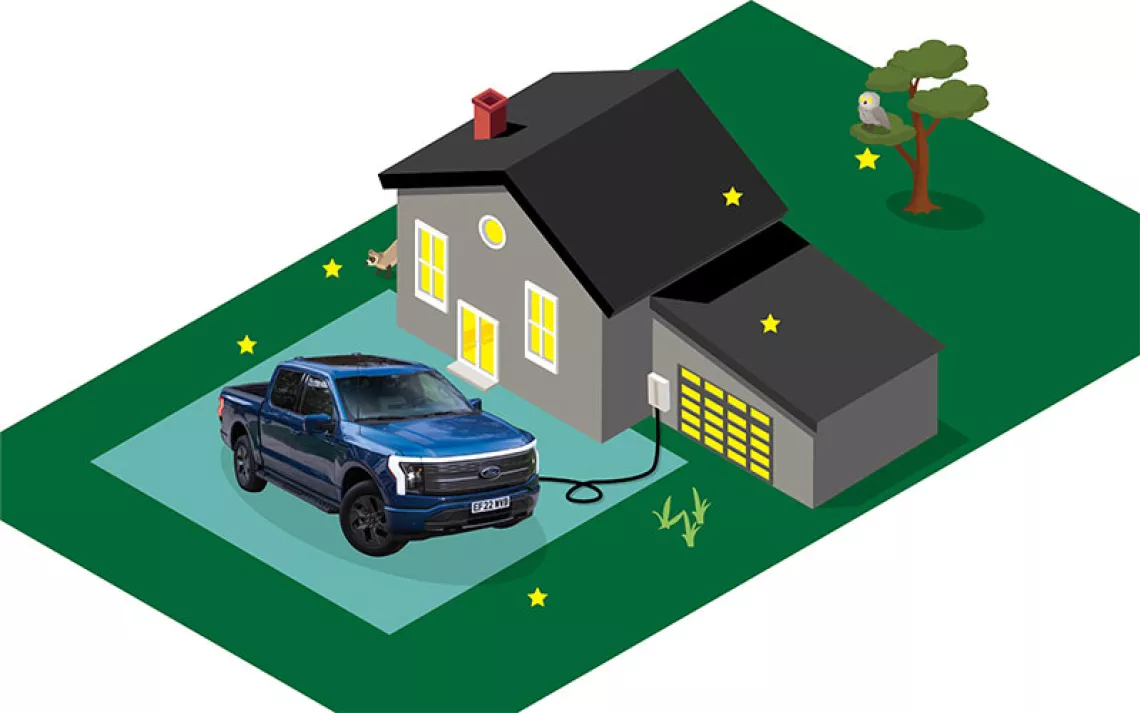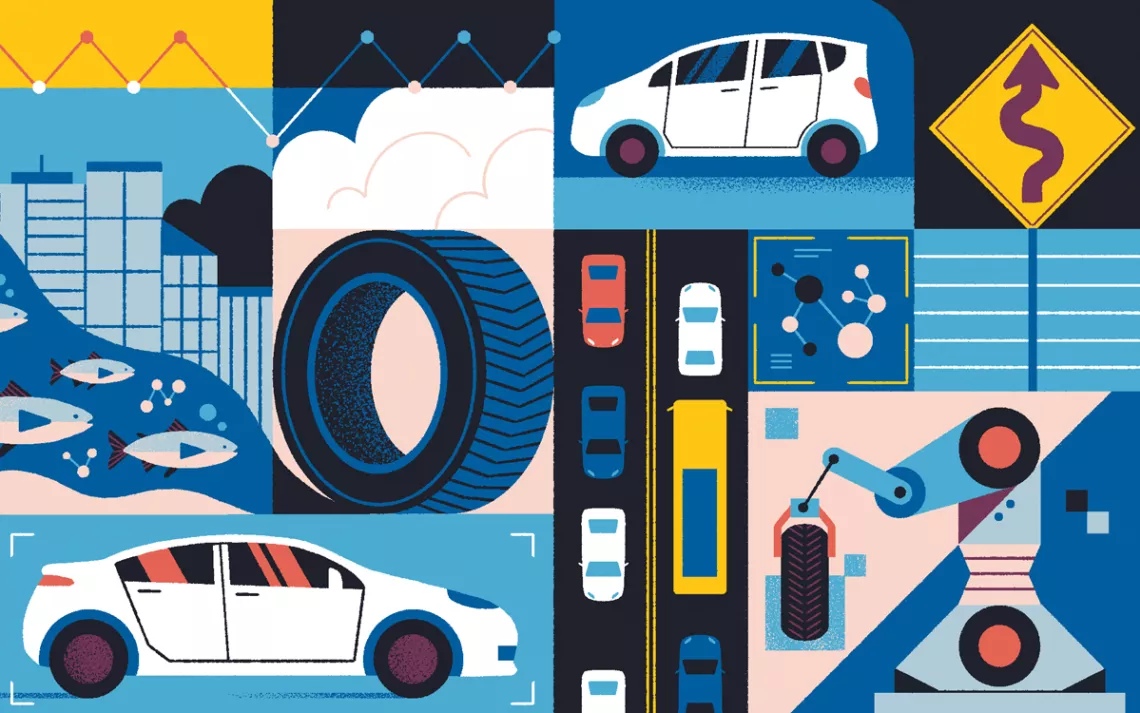Volkswagen's Cheating Scandal Could Have a Silver Lining
$4.7 billion could transform our transportation system

A desert graveyard near Victorville, California, holds some of the 350,000 Volkswagen and Audi diesel cars that VW bought back from customers for $7.4 billion. | Photo by Lucy Nicholson/Reuters
BETWEEN 2008 and 2016, German automaker Volkswagen perpetrated one of the largest and most brazen corporate deceptions in U.S. history. At a time when diesel vehicles were known to be generally more polluting than gasoline-powered models, Volkswagen sold nearly 600,000 diesel passenger cars in the United States under the VW, Porsche, and Audi brands as "clean diesel," proffering as evidence their sterling performance on emissions tests.
In 2014, researchers discovered that the company had built "defeat devices" into its cars to fool the tests. When not plugged in to an emissions-testing device, the cars emitted epic quantities of nitrogen oxide compounds. NOx is the key ingredient in smog as well as a cause of acid rain and ozone depletion, and it's a contributor to a host of respiratory ailments, including childhood asthma. Depending on whether they were driving on the highway or in stop-and-go traffic, VW's "clean diesel" vehicles were emitting between nine and 40 times more NOx than the EPA allowed.
When the dust settled from Dieselgate, Volkswagen's reputation was in tatters. U.S. prosecutors indicted former CEO Martin Winterkorn for violating the Clean Air Act, conspiracy to defraud the United States, and wire fraud (although his extradition is unlikely). After the EPA refused to clear VW's new models for sale, the company agreed to pay the United States $4.7 billion in restitution—a sum that, if used wisely, has the potential to transform the country's transportation system.
The VW settlement, reached in fall 2016, called for the establishment of a $2.7 billion Volkswagen Mitigation Trust, to be used for purchasing technology to remove the same amount of nitrogen oxide that the company's diesel fleet put into the atmosphere for eight years. These "mitigation funds" will be split among the states according to how many of the polluting cars were sold and driven in each.
VW must also invest another $2 billion in electric-car-charging infrastructure and the promotion of zero-emission vehicles (ZEVs). California gets $800 million from that pot of money, with the rest of the ZEV Investment Fund split among the other states. Joe Halso, a Denver-based associate attorney for the Sierra Club who focuses on clean transportation, calls it "a level of investment that can move markets."
State by state, plans are taking shape that could put those billions to work electrifying soot-spewing bus fleets and converting diesel-belching ferries to clean battery power. The investment is expected to launch a building boom in electric-car-charging networks and to decarbonize dirty rail-yard and dockside engines and cranes. Seed money from the Volkswagen settlement could also allow cities, school districts, and businesses to purchase big-ticket items such as electric transit and school buses, which have a daunting up-front price but a lifetime cost that's more manageable because of radically lower fuel and maintenance costs.
"We see this as a really big deal, a potential for transformative, forward-looking investments that reduce pollution," Halso says. "This is going to have a jump-start effect."
OR NOT. Halso commended a number of state plans—Colorado's, for instance—that have strong incentives for electrification. But the states have a great deal of leeway in spending the settlement funds, and Anne Blair, until recently the clean fuels program director for the Southern Alliance for Clean Energy in Atlanta, worries that some state plans—her home state of Georgia's, for one—may end up funding not zero-emission technology but natural gas, propane, or even newer diesel vehicles that provide modest emissions reductions while sticking with fossil fuels.
Georgia plans to use all of its $64 million share of the VW money to upgrade bus fleets. It will convert Atlanta International Airport's diesel shuttle buses to all-electric models and update the Atlanta metro area's bus system. But Georgia's plan, like those of many other states, is vague on critical details. That bus fleet could be a mix of electric and "clean diesel" models, or it could be fossil fuels all the way. The plan is purposely ambiguous, and Blair says there's no way to know at the moment how it will shake out.
So far 14 states have plans that will likely replace old diesel trucks, buses, locomotives, and other vehicles with newer fossil fuel choices rather than electric ones, based on a calculation that compares cost with the amount of pollution reduction. "Some of the state plans we're seeing are disappointing," Blair admits. "They are vague on key points, or they lack the potential for market transformation we hope to see."
UNFORTUNATELY, THE MAIN requirement for anything paid for with the VW settlement cash is NOx reduction, not carbon dioxide reduction or market transformation. NOx and fine soot—diesel's other major harmful emission—are the reasons diesels have been a problematic part of the transportation mix for more than a century. They're also why the widespread embrace of VW's supposedly clean technology, especially in Europe, led to horrendous air quality problems. Smog in Paris in recent years has at times been worse than the infamously bad air of Beijing, and diesel pollution is a major culprit.
Advanced testing in Europe in 2016 revealed that Volkswagen was not the only company with emissions problems—virtually every diesel passenger car by every carmaker exceeded NOx limits. Most recently, the U.S. Department of Justice accused Fiat Chrysler of bypassing emissions controls in 104,000 diesel vehicles sold since 2014.
To the delight of environmental organizations and child health advocates, school bus replacement has emerged as an early favorite in a number of state plans. Tamara Dzubay, a clean energy specialist at the Environmental Law and Policy Center in Chicago, has been working with school districts in the Midwest for the past two years, encouraging them to apply for the VW funds. Dzubay says she and her colleagues looked for diesel-replacement projects that delivered the most in terms of pollution reduction, public health effects, cost-effectiveness over the life cycle of a vehicle, benefits to a vulnerable population (the VW-funded projects are supposed to have a social and environmental justice component, favoring populations that have historically suffered most from emissions), and market-transformation potential. She says that nothing hits all those criteria better than the electrification of the nation's 480,000 mostly diesel-powered school buses.
"Electrifying school buses really stood out as the best opportunity," she says. "It's the largest fleet, more than two times that of transit buses and rail combined—it's actually the largest category of mass transportation. And it's also transporting the most vulnerable population. Kids are most susceptible to the negative health impacts of diesel pollution because their lungs are still developing. Those that ride school buses are exposed every single day."
The market for electric school buses has lots of room to grow. Nationwide, there are now only 160 electric buses, at a cost per vehicle of $230,000 (including charging system) versus $109,000 for diesel buses. Dzubay says the electric school bus market is where electric transit buses were seven years ago. Increased sales have driven transit-bus prices down by 40 percent, so their lifetime costs are now several hundred thousand dollars lower than those of their diesel counterparts. Significant investments of VW money in electric school buses should drive their prices down in the same way, Dzubay says. And even at current prices, electric buses become cheaper than diesel 12 years into their 16-year life spans.
Clean buses could be even cheaper if the states coordinated their purchases, but spending has been fractured. Illinois plans to dedicate $10 million of its $109 million share to electric school buses; Missouri is setting aside $12 million out of $41 million for cleaner buses, with no fuel type specified. Oklahoma will spend 20 percent of its $21 million on nondiesel buses. California, which gets the largest payout from the mitigation trust—$423 million—is devoting $130 million to zero-emission buses of all types, with school buses receiving up to half that amount, according to the state's draft plan.
Transit buses are another popular focus. Washington State plans to devote up to 45 percent of its $112.7 million to electrifying transit buses, plus a similar amount to marine transport, converting portions of the massive ferry fleet that plies the Puget Sound from old-school diesel to electric-battery power. Part of that money will also likely go to shore power for cargo vessels at the Port of Seattle, so docked container ships and other marine vessels can shut off their engines.
"We looked at where the pollution is, where communities are disproportionately impacted," says Camille St. Onge, communications manager for the Washington State Department of Ecology, which is administering the VW money. "It's right around the ports."
Electric cars will also see a big win in the downfall of diesel brought on by the VW scandal, and not just from the $2 billion for ZEV investments. All but a handful of states that have filed plans—and even some that have not drafted a plan yet—have committed to spending 15 percent of their settlements on charging infrastructure for zero-emission cars, the maximum percentage allowed under the terms of the settlement.
There is still time, in most states, for the public to weigh in on how the restitution funds are spent. As of press time, 18 states had fully crafted plans. Another 18 had yet to release specific plans, and the other 14 had draft plans that had been circulated for public comment.
"The Volkswagen Mitigation Trust is all about killing old diesel engines," Halso says. "Our view is killing those diesels and not putting fossil-fuel-burning engines back on the road is the best way to get the kind of market transformation we need to get us where we want to go."
This article was funded by the Sierra Club's Clean Transportation for All campaign (sc.org/transportation).
This article appeared in the September/October 2018 edition with the headline "VW's Silver Lining."
 The Magazine of The Sierra Club
The Magazine of The Sierra Club



